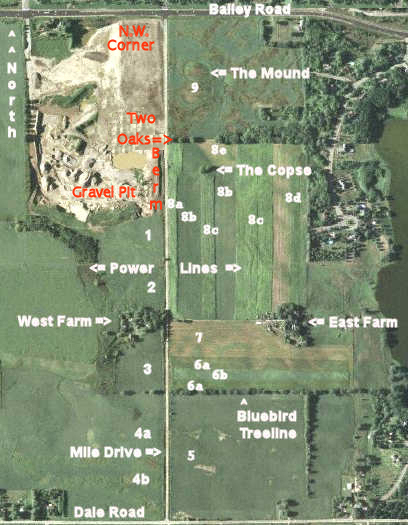
 This beautiful flower is the dwarf form of the purple bearded iris (Iris pumila L.).
The dwarf form is identified by it's short height (from 3 to 11 inches). I found a small group of these
plants on the west ditch of the gravel road across from The Mound.
Iris (Iris)-Iris comes from the Greek word for rainbow. In mythology, the goddess Iris, who was
Juno’s personal messenger, traveled over the rainbow to reach Earth. Brightly colored flowers
sprang up from her footsteps.
Return to Flora
This beautiful flower is the dwarf form of the purple bearded iris (Iris pumila L.).
The dwarf form is identified by it's short height (from 3 to 11 inches). I found a small group of these
plants on the west ditch of the gravel road across from The Mound.
Iris (Iris)-Iris comes from the Greek word for rainbow. In mythology, the goddess Iris, who was
Juno’s personal messenger, traveled over the rainbow to reach Earth. Brightly colored flowers
sprang up from her footsteps.
Return to Flora
|
|
|
 Iris have orchid-like flowers and originated in central Europe. Three upright petals are called
standards.
Three sepals hand downward
and are known as falls. Iris may have standards and falls of the same color or standards may be one
color and falls a different color. Principal iris colors are lavender, blue, white, purple, rose-red,
yellow, pink, brown or various combinations and blends of these colors. The beard is the fuzzy,
fringed appendage above the falls.
Iris have orchid-like flowers and originated in central Europe. Three upright petals are called
standards.
Three sepals hand downward
and are known as falls. Iris may have standards and falls of the same color or standards may be one
color and falls a different color. Principal iris colors are lavender, blue, white, purple, rose-red,
yellow, pink, brown or various combinations and blends of these colors. The beard is the fuzzy,
fringed appendage above the falls.
|
|
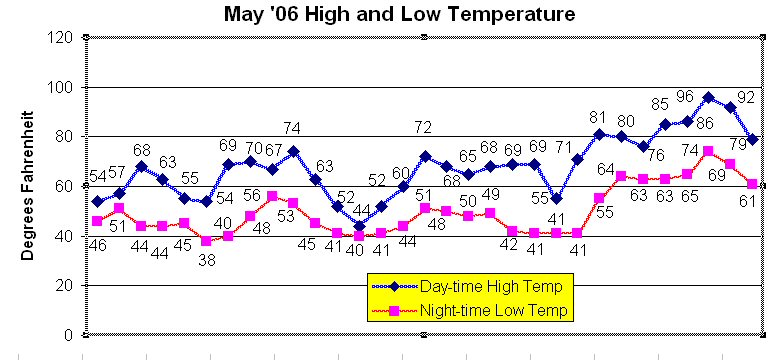
|



|
|
Common dandelion (Taraxacum officinale L.) Introduced to North America from Eurasia.
The foliage of dandelions is very palatable to most grazing and browsing wildlife, providing good
forage for white-tailed deer, antelope, pocket gophers, prairie dogs, rabbits, sharp-tailed grouse,
partridge, and Canada geese. Other game birds and small mammals use this species to a lesser extent.
Many songbirds, small mammals, and game birds use the seeds of dandelions as feed, especially
goldfinches and English sparrows. The leaves of this species have been used by humans as greens for
centuries. The flowers have been used for making dandelion wine. The root has been used for
medicinal purposes as a liver stimulant and mild laxative. The plant is a good honey
plant and is utilized by bees.
Return to Flora
|



|
|
Near the common dandelion are two different clumps of what appear to be mutant dandelions.
The leaves are similar to common dandelions, but smaller. They remind me of some kind of
toasted coconut candy. I looked around to make
sure nothing like broadleaf herbicide from the nearby field could have caused this. Regular dandelions
are all around these two plants, and the plants are not dying, so I think not.
I could not find these blooming again in 2007 - if they were indeed natural mutants perhaps
the mutation didn't produce seeds or blew off elsewhere. Return to Flora
|



|
|
This shrub is red elderberry (Sambucus racemosa L.).
Where you find one elder bush, you usually find many more since they are spread by
birds eating the fruit and then excreting the seeds.
Note the pyramidal clusters of small white flowers. The leaves have five to seven leaflets.
The plant will produce clusters of red berries.
Many books say the whole plant smells bad. These are directly under Two Oaks.
Return to Flora
|

On the rocks underneath the shrubs below Two Oaks
someone placed this object marking what must be the
grave of a ... dog perhaps? Was the
paw print made after death?
|


The elderly farmer is discing Field #7 again.
|


This is a clump of common blue violets (Viola sororia L.). I would love this to be
a clump of prairie violets, but the leaves aren't right. Violets grow in the west
ditch of Mile Drive along Field #3 and Field #4a.
Return to Flora
|
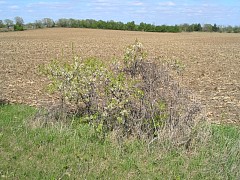

American wild plum (Prunus Americana L.). Wild plum trees generally grow along roadsides and
riverbanks at woodland and farmland borders. The white blossoms sometimes occur before
the leaves come out. This is in the east ditch along Field #5.
|

Since mid-April, across from Two Oaks I often hear rooster pheasants making the two-note "Hey I'm
an available rooster here" call. When I have the time, I walk over along The Berm and
try and flush him. This photo shows some of the cover behind The Berm.
 Destroyed mid-2006
Destroyed mid-2006

|

Spring is progressing quickly. This is toward the north end of Mile Drive looking
south toward the farms.
Quite a different view when compared back to the day of the March blizzard.
Note the telephone pole in the left foreground, it's the one in the pictures below.
|

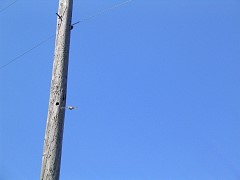
 Tree swallow (Tachycineta bicolor L.).
Tree swallows are medium-sized swallows with pure white under parts and slightly forked tails.
Adults in breeding plumage have glossy metallic blue upper parts tinged with green. The sides of
the head are colored blue-black. Wings and tail are sooty black with a faint green sheen.
Return to Birds
Tree swallow (Tachycineta bicolor L.).
Tree swallows are medium-sized swallows with pure white under parts and slightly forked tails.
Adults in breeding plumage have glossy metallic blue upper parts tinged with green. The sides of
the head are colored blue-black. Wings and tail are sooty black with a faint green sheen.
Return to Birds
|
|
Adult females are slightly duller
than males and may have brownish foreheads.
Tree swallows are the only swallows that make substantial use of vegetable food such as seeds and
berries. They favor bayberries. Eating berries when insects aren't available helps these swallows
withstand bad weather, especially during their early spring return to the breeding range.
The Tree swallow is a migratory bird and they migrate in large flocks by day and roost at night.
During the day, they can also be seen flying in circular motions, turning and winding in all
directions and skimming over meadows, streets and cities.
John James Audubon called this bird the "White-bellied swallow".
It was very windy, and the birds would glide into the wind and remain motionless. Pay attention to
the middle
picture - click on it and enlarge it. I believe it shows the bird just as it disappears into the
knothole in the pole. I believe they are nesting there.
|

A robin's egg is sky blue - but I haven't seen robins along the gravel road. This egg is
speckled - most likely it's not a robin's.
|


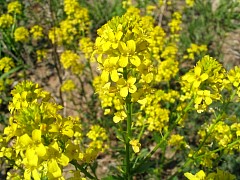
|
|
Early winter cress or yellow rocket (Barbarea verna L.) of the mustard family.
This alien plant was introduced to North America from Europe. Early settlers used
the plant as an edible and medicinal herb to prevent scurvy. It's one of the
first plants to flower and taken as a whole each free standing plant looks like an
exploding firework. Return to Flora
|



|
|
Stinkweed - also known as field pennycress (Thlaspi arvense L.). It was
introduced from Mediterranean region of Eurasia and is a member of the mustard family.
The whole plant has a sour turnip-garlic odor which is distasteful to most people, and
causes tainted milk when dairy cattle eat it. The center picture above is taken a perhaps
three weeks after the others and shows the pods that stinkweed form.
Return to Flora
|

Gene has both Field #7 and Field #6 ready. Field #7 will be oats,
Field #6a will be two strips of hay surrounded by Field #6b - a strip of corn.
It's
funny, he plants right up to (and in some turns INTO) the gravel road, leaving no
ditch. In all my years of driving around the countryside hunting pheasants I have never seen
this.
|

You may have to enlarge this picture to see the tall thin wild asparagus plants (Asparagus officinalis L.).
Asparagus is a perennial vegetable native to the Eastern Mediterranean area and
now naturalized over much of the world. The tender shoots of asparagus are cut and
eaten in the spring.
|

The trees between Field #3 and #4a directly across from Bluebird Treeline have almost filled out.
This pair is some variety of popular, which I will identify later.
|

Mr. and Mrs. hawk fly high over the road. Later I will have close-ups of this pair.
|